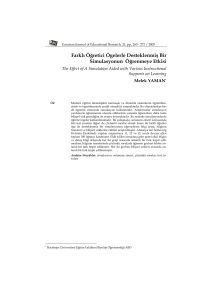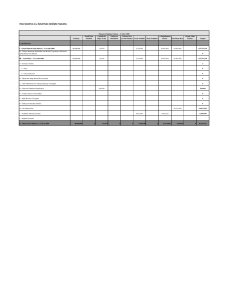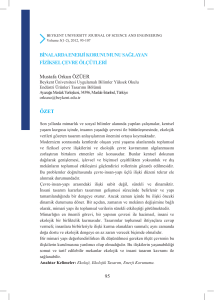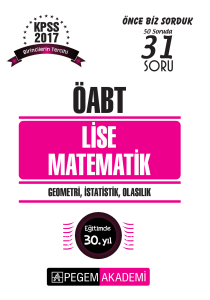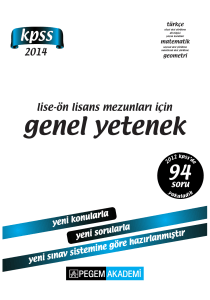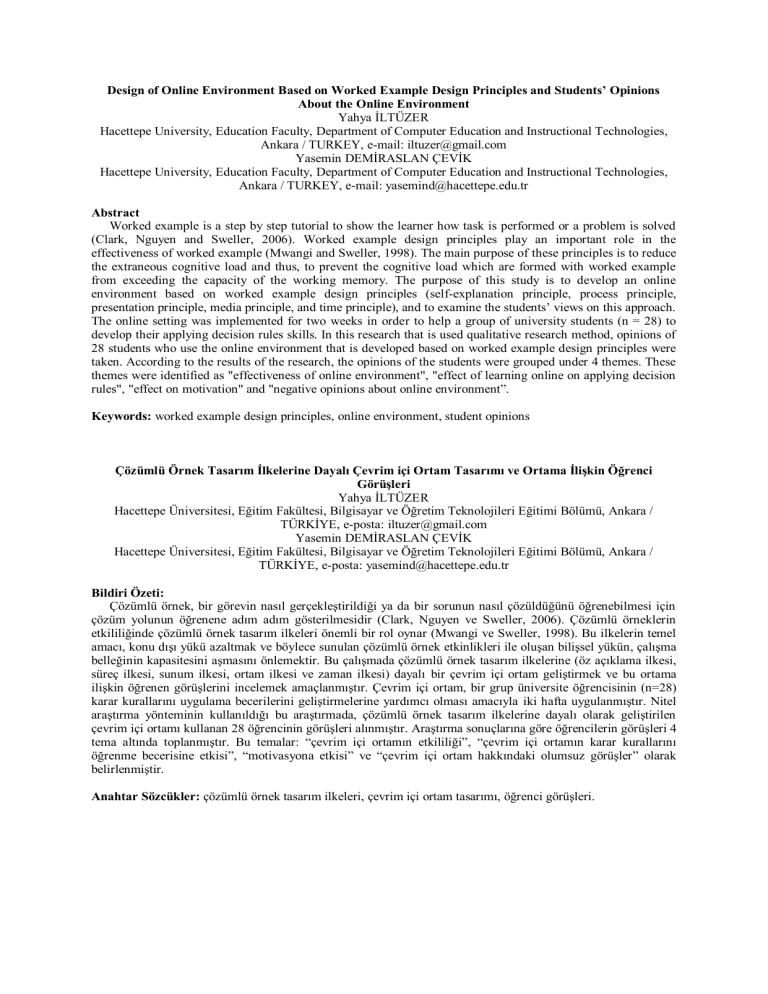
Design of Online Environment Based on Worked Example Design Principles and Students’ Opinions
About the Online Environment
Yahya İLTÜZER
Hacettepe University, Education Faculty, Department of Computer Education and Instructional Technologies,
Ankara / TURKEY, e-mail: [email protected]
Yasemin DEMİRASLAN ÇEVİK
Hacettepe University, Education Faculty, Department of Computer Education and Instructional Technologies,
Ankara / TURKEY, e-mail: [email protected]
Abstract
Worked example is a step by step tutorial to show the learner how task is performed or a problem is solved
(Clark, Nguyen and Sweller, 2006). Worked example design principles play an important role in the
effectiveness of worked example (Mwangi and Sweller, 1998). The main purpose of these principles is to reduce
the extraneous cognitive load and thus, to prevent the cognitive load which are formed with worked example
from exceeding the capacity of the working memory. The purpose of this study is to develop an online
environment based on worked example design principles (self-explanation principle, process principle,
presentation principle, media principle, and time principle), and to examine the students’ views on this approach.
The online setting was implemented for two weeks in order to help a group of university students (n = 28) to
develop their applying decision rules skills. In this research that is used qualitative research method, opinions of
28 students who use the online environment that is developed based on worked example design principles were
taken. According to the results of the research, the opinions of the students were grouped under 4 themes. These
themes were identified as "effectiveness of online environment", "effect of learning online on applying decision
rules", "effect on motivation" and "negative opinions about online environment”.
Keywords: worked example design principles, online environment, student opinions
Çözümlü Örnek Tasarım İlkelerine Dayalı Çevrim içi Ortam Tasarımı ve Ortama İlişkin Öğrenci
Görüşleri
Yahya İLTÜZER
Hacettepe Üniversitesi, Eğitim Fakültesi, Bilgisayar ve Öğretim Teknolojileri Eğitimi Bölümü, Ankara /
TÜRKİYE, e-posta: [email protected]
Yasemin DEMİRASLAN ÇEVİK
Hacettepe Üniversitesi, Eğitim Fakültesi, Bilgisayar ve Öğretim Teknolojileri Eğitimi Bölümü, Ankara /
TÜRKİYE, e-posta: [email protected]
Bildiri Özeti:
Çözümlü örnek, bir görevin nasıl gerçekleştirildiği ya da bir sorunun nasıl çözüldüğünü öğrenebilmesi için
çözüm yolunun öğrenene adım adım gösterilmesidir (Clark, Nguyen ve Sweller, 2006). Çözümlü örneklerin
etkililiğinde çözümlü örnek tasarım ilkeleri önemli bir rol oynar (Mwangi ve Sweller, 1998). Bu ilkelerin temel
amacı, konu dışı yükü azaltmak ve böylece sunulan çözümlü örnek etkinlikleri ile oluşan bilişsel yükün, çalışma
belleğinin kapasitesini aşmasını önlemektir. Bu çalışmada çözümlü örnek tasarım ilkelerine (öz açıklama ilkesi,
süreç ilkesi, sunum ilkesi, ortam ilkesi ve zaman ilkesi) dayalı bir çevrim içi ortam geliştirmek ve bu ortama
ilişkin öğrenen görüşlerini incelemek amaçlanmıştır. Çevrim içi ortam, bir grup üniversite öğrencisinin (n=28)
karar kurallarını uygulama becerilerini geliştirmelerine yardımcı olması amacıyla iki hafta uygulanmıştır. Nitel
araştırma yönteminin kullanıldığı bu araştırmada, çözümlü örnek tasarım ilkelerine dayalı olarak geliştirilen
çevrim içi ortamı kullanan 28 öğrencinin görüşleri alınmıştır. Araştırma sonuçlarına göre öğrencilerin görüşleri 4
tema altında toplanmıştır. Bu temalar: “çevrim içi ortamın etkililiği”, “çevrim içi ortamın karar kurallarını
öğrenme becerisine etkisi”, “motivasyona etkisi” ve “çevrim içi ortam hakkındaki olumsuz görüşler” olarak
belirlenmiştir.
Anahtar Sözcükler: çözümlü örnek tasarım ilkeleri, çevrim içi ortam tasarımı, öğrenci görüşleri.

